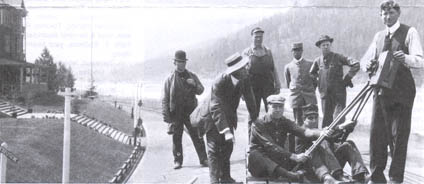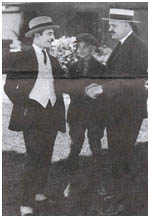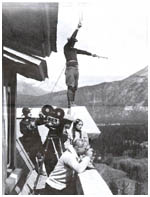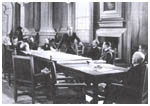
Volume 14
Number 13
Oct. 3, 1984
|
 |
CPR Line Through the Rockies a Popular Location for Canada's
Early Films
By Dave
Jones

Fillers: With the director
(foreground, white hat) pointing out the shot he wants, a crew from the Edison Film Company films a sequence of
cars coupling in front of the platform of the Canadian Pacific mountain hotel, the Mount Stephen House, circa
1910.
Although the great advertising
potential of still photography was immediately recognized by the railway builders in the 1880s, nothing could
capture the public's imagination like the advent of motion pictures.
LIVING CANADA
| |

Pioneer: Canadian Motion picture pioneer, Ernest
Ouimet, shakes hands with Paul Morency of Astra films as son Louis Ouimet looks
on.
|
As early as the turn of the century, Canadian Pacific was exploring this new and fascinating medium as a means
of promoting its interests.
In 1900, the Charles Urban Trading Company of England sent photographers Cliff Denham, F. Guy Bradford, and Joe
Rosenthal to Canada to work on a number of films which were eventually released as the "Living Canada
Series".
The main purpose of the series was to promote immigration to Canada, so most of the filming was done during the
summer months over a two-year period, as Canadian Pacific did not want to strengthen the popular
misconception of Canada as a land of perpetual ice and snow.
| |

A Little to the Left Please: The film crew of
"The Alaskan" used semaphore signals to direct the action in the Bow River Valley below the Banff
Springs Hotel.
|
Robert Kerr, passenger traffic manager; George Ham, publicity agent; and L.O. Armstrong, colonization agent were
assigned by the railway to liaise with the film-makers and facilitate their travels across the
system.
For the North American market, the value of such projects became apparent during the ensuing decade as nickel
movie houses proliferated across the continent.
Although railway management debated the merits of aiming their shows at the clientele which frequented these
houses, by 1909 several of Canadian Pacific's officers felt strongly enough about the subject to convince the
company's president, Sir Thomas Shaughnessy, to approve an expenditure of five thousand dollars for a moving
picture exhibit at Seattle's "Alaska-Yukon Exposition", to encourage tourism and
immigration from the United States.
SHIPS TOO
| |

Brave and True: Strongheart, an
early-era film star poses with his director and tudor, Laurence Trimble (left) and W.W. Grant
of "The Albertan", while broadcasting an invitation to the Banff Winter Carnival and
100-mile Grand Prix dog sled race.
|
However, the most ambitious attempt to accomplish this dual purpose was made in the summer of 1910, when the
Edison Manufacturing Company of New York created 13 pictures along Canadian Pacific's right-of-way
between Montreal and Victoria and on the Soo Line, a subsidiary railway in the United States.
For a two-month period, the troop of actors and actresses, along with their stage manager, had
hotels, trains, mountain guides, railway crews, and even a 10,000 ton ocean-going steamship at their
disposal.
Intended for theatres in the United States, Canada, and Great Britain, the films were mini-dramas
and mini-comedies.
With titles like "An Un-Selfish Love", "The Little Station Agent", and "The
Cowpuncher's Glove", these films were meant to be entertaining as well as instructive.
| |

Leading Lady: Miss Wanda Winters checks her make up
on the set of "The Alaskan", with the Banff Springs Hotel in the
background.
|
As a contemporary journal explained: "What does Johnny the conductor from East Harlem care about the
mining industry in British Columbia or the ranching industry in Alberta? Not a rap. Not a jot, nor a tittle. He
and his girl go to see the show for the fun they'll get out of it".
One of the most successful of the early cinema entrepreneurs in Canada was Ernest Ouimet who's Ouimetoscope
Theatre opened in Montreal in 1906. Ouimet was employed by Canadian Pacific for several years to make promotional
films.
The great success of such ventures in producing films in Canada led to the formation in 1924 of Associated Screen
News in which Canadian Pacific had a considerable financial interest.
Located in Montreal, their original intent was to produce motion picture films for Canadian industry.
By the end of the decade, not only did they have nearly every Canadian corporation as their clients, but they had
extended their activities to scenic, travel, and adventure films.
Associated Screen News eventually became a part of the Bellevue Pathe film empire.
ACTION-PACKED
| |

All-Canadian: In the 1935 release "Silent
Barriers", James J. Hill (standing) urges the CPR board to abandon their plans to build the entire
line in Canada, and join the tracks with his Great Northern Railway in the United
States.
|
The Rocky Mountains in particular were the backdrop for Canadian movies made during the 1920s, although the
prairies and maritimes were also popular.
Among the most notable movies filmed wholly or in part along Canadian Pacific's lines were; "Back to God's
Country", "The Sky Pilot", "Glengarry Schooldays", "The Man from Glengarry",
"Frivolous Sal", "Strongheart", "The Foreigner", and "The Alaskan".
Much of "The Alaskan", a Famous Players-Lasky film, was shot in the vicinity of the Banff
Springs Hotel and featured movie stars Thomas Meighan and Wanda Winters.
Literally hundreds of films have been produced since then, using the railway's facilities in one way or another,
but two in particular are of special interest as they portrayed the construction years of the Canadian Pacific
Railway, with varying degrees of authenticity.
In 1935 and 1936, Gaumont British Films produced "Silent Barriers", a fairly serious attempt at showing
the drama of the construction period, but the story took on a distinct "wild west" flavor when
Twentieth-Century Fox shot "Canadian Pacific" in 1949.
This film starred Randolph Scott and Jane Wyatt and featured action-packed scenes of
hard-driving, gun-slinging surveyors, and indians shooting flaming arrows at railway
hospital cars.
Not exactly the way the railway would have told the story perhaps, but it did capture the attention of thousands
of moviegoers.
This CP Rail News article is copyright
1984 by Canadian Pacific Railway and is reprinted here with their permission. All photographs, logos, and
trademarks are the property of the Canadian Pacific Railway Company.
|
|